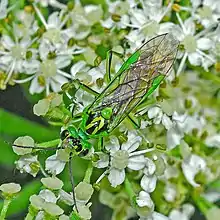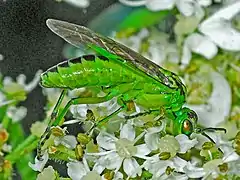Rhogogaster viridis
Rhogogaster viridis, common name green sawfly, is a species of common sawfly in the family Tenthredinidae. [1]
| Rhogogaster viridis | |
|---|---|
 | |
| Adult of Rhogogaster viridis | |
| Scientific classification | |
| Kingdom: | Animalia |
| Phylum: | Arthropoda |
| Class: | Insecta |
| Order: | Hymenoptera |
| Suborder: | Symphyta |
| Family: | Tenthredinidae |
| Genus: | Rhogogaster |
| Species: | R. viridis |
| Binomial name | |
| Rhogogaster viridis (Linnaeus, 1758) | |
| Synonyms | |
| |
Subspecies
Subspecies include: [2][3]
- Rhogogaster viridis subsp. montana (Betrem, 1933)
- Rhogogaster viridis subsp. viridis
Distribution and habitat
This species is present in most of Europe (Albania, Austria, Belarus, Belgium, Bosnia and Herzegovina, Bulgaria, Central European Russia, Croatia, Czech Republic, Denmark, Estonia, Finland, France, Germany, Greece, Ireland, Italy, Latvia, Luxembourg, North Macedonia, Norway, Poland, Portugal, Romania, Sweden, Switzerland, Netherlands, and former Yugoslavia) and in the Nearctic realm. [4] These rather common sawflies can be found mainly in grassy environment, gardens and parks rich in green leaves.
Description

Rhogogaster viridis can reach a body length of about 10–13 mm (0.39–0.51 in). [5] These wasps have light green head and body. The head shows a black drawing in the form of the Greek letter omega, The wings are transparent, with a pterostigma uniformly green or yellow. On the sides of the thorax is present a small black line. On the back of the abdomen of the females [5] there is a black band. [6] The female have a saw-like ovipositor.
This species is rather similar to Tenthredo olivacea Klug, 1814 and to Rhogogaster chlorosoma (Benson, 1943).
Biology
Adults can be found from April to August.[7] They mainly feed on pollen and nectar but, on sunny summer days, they hunt for insects and suck out their body fluids, feeding especially on Colorado Potato Beetle (Leptinotarsa decemlineata).[8] The larvae are similar to caterpillars, but they have six true legs and several abdominal prolegs. They are phytophagous and feed on a wide range of plant leaves (Quercus (Fagaceae), Stellaria (Caryophyllaceae), Filipendula (Rosaceae), Circaea (Onagraceae), Alnus (Betulaceae), Rubus (Rosaceae), Salix viminalis (Salicaceae), Chamaenerion angustifolium (Onagraceae), Salix and Populus (Salicaceae). [9]
Bibliography
- Ross H. Arnett, Jr. American Insects: A Handbook of the Insects of America North of Mexico, Second Edition CRC Press
- Krombein, Karl V. Catalog of hymenoptera in America north of Mexico Smithsonian Institution Press
- Zhelokhovtsev A.N., Tobias V.I., Kozlov M.A. 1993. -. Vol. 3. Hymenoptera. Part 6.
References
| Wikispecies has information related to Rhogogaster viridis. |
| Wikimedia Commons has media related to Rhogogaster viridis. |